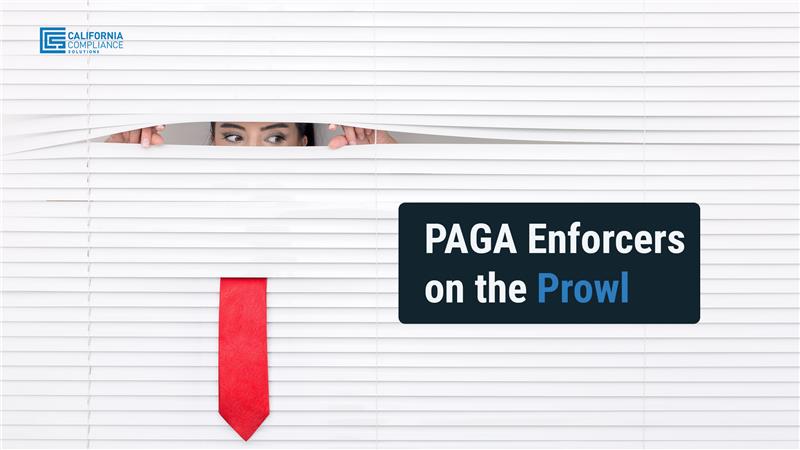This is the fourth part of our five-part series on Why You Should Treat Wage and Hour Compliance Like Safety in California.
In Part 1 of this series, we compared health and safety practices with wage and hour compliance, demonstrating how wage and hour lawsuits threaten California employers more due to a lack of administrative or preventative infrastructure.
In Part 2, we shared how wage and hour exposure often involves all your California hourly (non-exempt) employees and includes up to four years of previous violations.
In Part 3, we showed you how wage and hour penalties can add up very quickly for California employers. For example, a single meal period infraction can result in $50, $60, or sometimes even $100 of potential exposure per meal period!
There’s more to this story, though. As we continue our comparison of the health and safety landscape with wage and hour compliance in California, the plot takes a devastating turn for California employers. Read on as we show you exactly how California’s enforcement system for wage and hour compliance pits employees against employers and incentivizes wage and hour lawsuits.

Cal/OSHA: The Enforcement System for Health and Safety We All Know and Love
Have you ever experienced this situation? Someone at your workplace (or any workplace) notices a safety violation and jokingly blurts out, “Uh oh! That’s not safe. Somebody call OSHA!”
That’s not just a joke—it’s a real thing that happens all the time.
When there is a health and safety violation, people call Cal/OSHA. California’s health and safety enforcement system is primarily governed by the California Division of Occupational Safety and Health (Cal/OSHA), which operates under the California Department of Industrial Relations. Cal/OSHA is responsible for enforcing state workplace health and safety regulations.
- Cal/OSHA establishes and enforces regulations and standards to ensure safe and healthy working conditions in California workplaces. These regulations cover many areas, including hazard communication, personal protective equipment, workplace ergonomics, and specific industry hazards.
- Cal/OSHA conducts inspections of workplaces to ensure compliance with health and safety regulations. Inspections may be conducted in response to employee complaints, referrals from other agencies, or as part of targeted enforcement efforts.
- If Cal/OSHA inspectors identify violations during an inspection, they may issue citations and penalties to employers. Penalties can vary depending on the severity of the violation, the employer’s history of compliance, and other factors.
- Employers can appeal Cal/OSHA citations and penalties through an administrative process. This allows employers to contest alleged violations and penalties and seek resolution through informal conferences, administrative hearings, or other means.
- Cal/OSHA provides training and educational resources to help employers understand and comply with health and safety regulations. This includes workshops, seminars, online resources, and consultation services.
As a result of Cal/OSHA and its supporting infrastructure, California employers are all too familiar with the regulations, training, procedures, costs, legal risks, and cultural implications related to health and safety. They know that compliance with California’s health and safety regulations is essential for the welfare of their employees and the well-being of their businesses. They understand how to comply with health and safety regulations and the potential costs associated with non-compliance.
What they don’t realize, however, is that the enforcement system for wage and hour compliance is very different and increases their exposure significantly.
We’re Definitely Not in Kansas, Anymore: California’s Wage and Hour Enforcement System Pits Everyone Against Each Other
Unlike safety claims that are largely processed through Cal/OSHA’s administrative body, California devised a different system for wage and hour compliance.
The department responsible for enforcing wage and hour compliance is the California Division of Labor Standards Enforcement (DLSE), which is part of the California Department of Industrial Relations. The DLSE is responsible for ensuring that employers in California comply with state labor laws related to minimum wage, overtime pay, meal and rest breaks, recordkeeping, and other aspects of wage and hour regulations.
Thanks to the state’s class action laws and PAGA, however, California’s wage and hour enforcement system is best described as a bounty-hunter system of enforcement because it allows private individuals, such as employees or their representatives, to act as “bounty hunters” or private attorneys general to enforce wage and hour laws on behalf of themselves and others. This is primarily due to the provision of the Private Attorneys General Act (PAGA), which allows aggrieved employees to sue their employers for Labor Code violations on behalf of themselves and other employees.
The state has deputized every employee and lawyer in California to bring a civil lawsuit to enforce California’s wage and hour laws.
This means any employee and lawyer can team up to bring a penalty enforcement lawsuit against your business on behalf of (most often) a large portion or all your nonexempt hourly employees.
Lawyers and their clients are incentivized to file these lawsuits because they are generally low risk and produce a bounty through attorneys’ fees and incentive payments to the employees bringing the suit. The incentives here are often extravagant, particularly for the lawyers, who often receive 30- 40% of whatever they recover on behalf of the employee class or PAGA group. For instance, an employee’s lawyer typically takes $300,000 to $400,000 of a $1 million settlement or judgment, often doing little work. This has inspired many lawyers to go bounty hunting and get rich. Many of the wage and hour lawyers filing these claims on behalf of employees are multimillionaires and some of the wealthiest lawyers in California.
Overall, the bounty-hunter characterization underscores the significant role that private individuals and their attorneys play in enforcing wage and hour laws in California, often acting as a supplement to, or in some cases, a substitute for, government enforcement efforts.
Level-Up Your Wage and Hour Compliance
California employers must recognize their vulnerability to wage and hour lawsuits and take proactive steps to minimize this risk. Those who have faced such lawsuits know firsthand their considerable financial burden. For those yet untouched, the threat looms inevitably. Employers must prioritize wage and hour compliance, crafting robust strategies to navigate the complexities of labor laws and minimize exposure to violations.
One strategy to consider would be emulating the health and safety practices you probably already have in place. For instance, do you train and certify your employees on health and safety? You can do the same for wage and hour compliance with sour wage and hour training for hourly non-exempt employees and managers in California.
Watch out for those bounty hunters, start taking wage and hour compliance seriously, and maybe, just maybe, you can avoid the stress and expenses of a wage and hour lawsuit.
Discover the essential best practices every California employer needs to know in Part 5 of this series.



